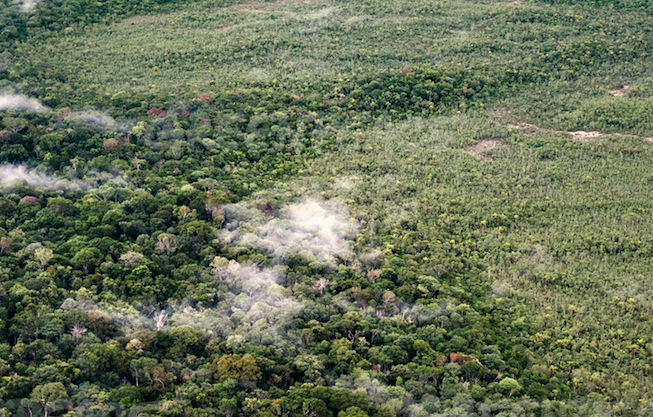
Last year Brazil impeached its president, Dilma Rousseff. Since then new Brazilian President Michel Temer has repeatedly given strong signals that the country's powerful agriculture interests will have more say on everything from imports to land ownership. And with Latin America’s largest economy enduring its worst recession in over 100 years, its business community is eyeing lands the Brazilian government recently promised would be protected.
Greenpeace says such a policy reversal would leave around 1 million hectares of land, an area larger than Yellowstone National Park, at risk of deforestation. Aerial photographs taken by a Greenpeace team in Brazil indicate areas around these lands are already being primed for development.
After years of steady decline, Greenpeace claims deforestation in Brazil’s Amazon increased 75 percent between 2012 and 2015. Nevertheless, President Temer’s administration is considering a proposal from the country’s National Congress to cancel one designated conservation area and reduce the size of four others by about 40 percent.
“These forests are being cleared for global commodities such as animal feed, as well as cattle products such leather and meat – which end up exported to Europe and elsewhere all over the world,” Daniel Brindis, a campaigner for Greenpeace, told TriplePundit.
Some Brazilian politicians say these conservation units are an obstacle to economic development. But the photographs reveal that landowners, or business interests well connected to the federal government, already had designs on these lands even before a change in policy became official.
Greenpeace says that so far there is little evidence of development underway other than the construction of roads and mining operations. But some areas have already been burned or cleared of forests, suggesting signs of new farms or timber logging.
Local and indigenous communities depend on these lands, Greenpeace says. “The fact is that you have the people in traditional communities who rely on them to survive,” Brindis told us.
And that's only the start of why these forests should continue to be preserved. “In addition, these forests have critical roles that vary from pollinators to some of their plants’ untapped potential as pharmaceutical ingredients.”
Brindis also made the case that the amount of deforestation occurring in Brazil has pushed these lands to a tipping point. He described deforestation’s effects as a “beachhead factor,” at which once a formerly forested area is opened to industrialization and then, as more people move in, additional pressure is imposed on the remaining local forest.
“We don’t talk enough about these forests’ roles in regulating local temperatures, as they help absorb heat so that surrounding areas are much more tolerable in which to live,” Brindis explained. “There’s only so much forest that can be used until you reach a point where the forest starts to degrade on its own or even becomes vulnerable to fires.”
The Brazil’s insistence that it must develop more virgin forests comes despite the fact that other environmental NGOs, including Mighty Earth, say as much as 200 million hectares of land is degraded across South America that could instead be primed for use such as soy cultivation or cattle ranching.
Furthermore, Brazil’s meat industry, as is the case with much of the world’s beef sector, is highly inefficient: The average head of cattle needs one hectare. While feedlots for North American cattle operations have long drawn the ire of environmental groups, some analysts make the case that they are more effective for raising cattle. “Brazilian cattle ranchers could raise even more cattle on the pastures they have now by reforming how they currently treat those lands,” Brindis said.
Brazil’s beef supply chain is also much more nebulous than the livestock sectors in other countries. In the U.S. and Canada, for example, companies often own or can closely monitor heads of cattle from breeding to slaughter. But despite the efforts of large Brazilian meatpacking companies such as JBS, Minerva and Marfrig, cattle in Brazil are often bought and sold with no traceability. As a result, indirect suppliers are often responsible for actions such as land-grabbing and deforestation.
As Brindis explained, there is no simple solution to solving this problem. Wealthy countries like Norway and Germany fund forest conservation programs in Brazil and other nations and are doing their part. And the decades-long fight to “save the Amazon” has matured. More activists now realize that the locals who rely on forests for their livelihood are often the best stewards of these lands. They must be part of the solution and need a voice to ensure current and future sustainable development.
But consumers also bear much of the responsibility to ensure these lands are not developed just to enrich the already wealthy and well-connected.
“The framework to stop deforestation is there, and people are paying more attention,” Brindis told us. “But the big question is: Who is going to pay for this?”
If ranchers are willing pay more for better fencing and land management, and meat producers pay for better supply chain monitoring, then consumers must be willing to pay more at the checkout aisle.
Image credit: Greenpeace

Leon Kaye has written for 3p since 2010 and become executive editor in 2018. His previous work includes writing for the Guardian as well as other online and print publications. In addition, he's worked in sales executive roles within technology and financial research companies, as well as for a public relations firm, for which he consulted with one of the globe’s leading sustainability initiatives. Currently living in Central California, he’s traveled to 70-plus countries and has lived and worked in South Korea, the United Arab Emirates and Uruguay.
Leon’s an alum of Fresno State, the University of Maryland, Baltimore County and the University of Southern California's Marshall Business School. He enjoys traveling abroad as well as exploring California’s Central Coast and the Sierra Nevadas.














